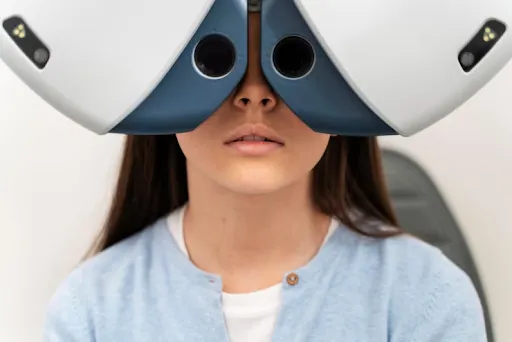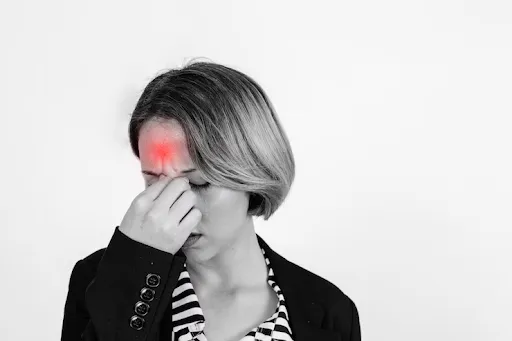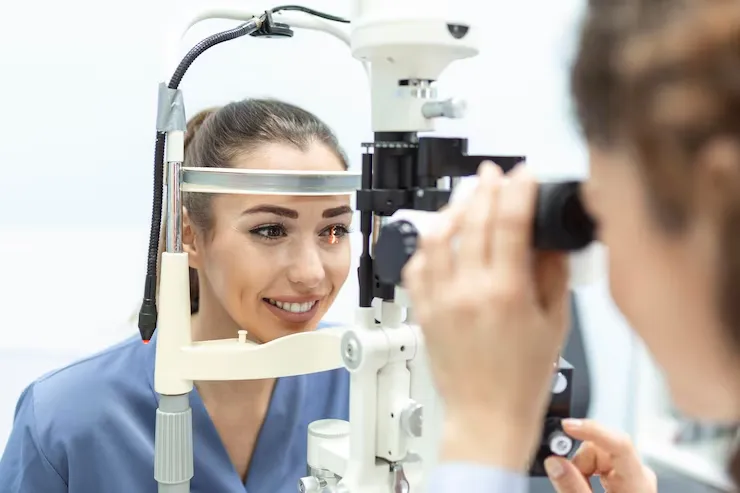Eye Conditions
Understanding Binocular Vision Dysfunction (BVD)
FSDAVCFEBFEVSDDVFSD
FSDAVCFEBFEVSDDVFSD
FSDAVCFEBFEVSDDVFSD
What Is Binocular Vision Dysfunction?
Binocular Vision Dysfunction (BVD) occurs when your eyes struggle to work together as a team. Even a minor misalignment can force the eye muscles to work overtime, leading to blurry vision, dizziness, and frequent headaches. Many patients experience difficulty focusing during tasks like reading, using a computer, or driving, often without realizing that eye misalignment is the root cause.
Although common, BVD is often overlooked during standard eye exams because symptoms mimic other conditions like migraines or vertigo. At Kleinwood Vision, our team uses specialized tests to accurately diagnose BVD, allowing patients to find real answers and lasting relief.
Binocular Vision Dysfunction (BVD) occurs when your eyes struggle to work together as a team. Even a minor misalignment can force the eye muscles to work overtime, leading to blurry vision, dizziness, and frequent headaches. Many patients experience difficulty focusing during tasks like reading, using a computer, or driving, often without realizing that eye misalignment is the root cause.

Although common, BVD is often overlooked during standard eye exams because symptoms mimic other conditions like migraines or vertigo. At Kleinwood Vision, our team uses specialized tests to accurately diagnose BVD, allowing patients to find real answers and lasting relief.

Symptoms and Daily Impact of BVD
Living with undiagnosed binocular vision dysfunction (BVD) can have a major impact on daily life. Many patients report persistent headaches, double vision, light sensitivity, and neck or shoulder pain. These symptoms often worsen during activities that require sustained visual focus, such as working on a computer, reading, or driving. Over time, the visual strain can lead to chronic discomfort, making it difficult to stay productive or enjoy daily routines.
Dizziness and unsteadiness are also common symptoms of BVD. These issues often cause confusion, as they can easily be mistaken for balance disorders or inner ear problems. When the eyes are misaligned, the brain struggles to fuse the two images into one, creating constant tension and fatigue. This hidden source of stress can leave patients feeling frustrated and exhausted without knowing why.
Ignoring BVD symptoms can severely affect job performance, academic success, and personal well-being. Tasks that once felt easy can become challenging, leading to decreased confidence and increased anxiety. Recognizing the signs of BVD early and seeking a comprehensive vision evaluation is key to finding relief. Proper diagnosis and treatment not only ease visual discomfort but also dramatically improve daily functioning, quality of life, and overall happiness. Don’t let undiagnosed BVD hold you back.
How Kleinwood Vision Diagnoses BVD

Detecting binocular vision dysfunction (BVD) requires specialized testing beyond a standard eye exam. At Kleinwood Vision, our comprehensive eye exams include in-depth assessments specifically designed to uncover even subtle eye misalignments. We go beyond checking visual acuity, using advanced diagnostic methods to better understand how your eyes work together.
One of the key tools we use is the Neurolens Measurement Device, which precisely measures eye misalignment and quantifies visual stress levels. These objective results allow our doctors to create a customized treatment plan tailored to your specific needs.

Through targeted evaluations, we can accurately diagnose BVD and guide patients toward meaningful relief. Our approach focuses not only on improving vision but also on minimizing the visual strain that leads to chronic symptoms like headaches, dizziness, and neck pain. Early diagnosis and personalized care make a significant difference in restoring comfort and daily function.
NeuroLens offers groundbreaking relief for patients suffering from Binocular Vision Dysfunction (BVD). These specialized lenses feature a unique prism design that gently corrects subtle eye misalignments, significantly reducing the strain responsible for headaches, dizziness, neck pain, and blurry vision. Each pair of NeuroLens glasses is custom-crafted based on precise measurements, ensuring the highest level of alignment correction and all-day comfort. Many patients report noticeable symptom improvements within just a few weeks of beginning NeuroLens treatment.
When paired with regular vision evaluations, NeuroLens therapy leads to better long-term outcomes. Addressing the root cause of visual misalignment not only brings immediate relief but also supports overall eye health and reduces the risk of future vision issues. Kleinwood Vision is proud to offer this advanced solution, helping patients reclaim comfort, improve their focus, and enjoy daily activities without the constant burden of visual strain
Additional Strategies for Managing BVD
In addition to NeuroLens, Kleinwood Vision recommends personalized strategies to effectively manage BVD symptoms. These approaches often include visual therapy exercises to strengthen eye coordination, ergonomic adjustments to workstations to promote better posture, and scheduled breaks from screens to reduce visual fatigue. Together, these methods support overall eye alignment and help ease the daily strain caused by Binocular Vision Dysfunction.
Early detection through routine comprehensive eye exams and consistent symptom monitoring are crucial to preventing BVD from worsening over time. By combining NeuroLens therapy with tailored support strategies, patients build a strong foundation for lasting visual comfort. Taking proactive steps and following a personalized care plan allows patients to regain visual clarity, minimize headaches, reduce neck and shoulder pain, and restore their overall sense of wellness, leading to a better quality of life both at work and at home.
Misdiagnosis: A Common Issue with BVD
Misdiagnosis is one of the biggest hurdles for patients suffering from BVD. Symptoms often overlap with other conditions like migraines, vertigo, or sinus issues, leading many to undergo unnecessary treatments without finding real relief. This cycle can leave patients feeling frustrated and hopeless.
Standard vision screenings may miss subtle eye alignment problems, making specialized testing essential. Without identifying the root cause, symptoms often persist and even worsen over time. Proper diagnosis is critical to breaking this pattern and finding an effective solution.

Misdiagnosis is one of the biggest hurdles for patients suffering from BVD. Symptoms often overlap with other conditions like migraines, vertigo, or sinus issues, leading many to undergo unnecessary treatments without finding real relief. This cycle can leave patients feeling frustrated and hopeless.
Standard vision screenings may miss subtle eye alignment problems, making specialized testing essential. Without identifying the root cause, symptoms often persist and even worsen over time. Proper diagnosis is critical to breaking this pattern and finding an effective solution.
At Kleinwood Vision, we believe accurate diagnosis is the foundation for lasting relief and a better quality of life. Our team uses advanced technology and comprehensive evaluations to precisely identify BVD. This approach allows us to offer real, targeted solutions rather than temporary fixes, helping patients finally achieve the comfort and clarity they deserve.
At Kleinwood Vision, we believe accurate diagnosis is the foundation for lasting relief and a better quality of life. Our team uses advanced technology and comprehensive evaluations to precisely identify BVD. This approach allows us to offer real, targeted solutions rather than temporary fixes, helping patients finally achieve the comfort and clarity they deserve.
Why Choose Kleinwood Vision for BVD Care?
Kleinwood Vision offers expert care for patients struggling with BVD symptoms. Our experienced optometrists are trained to detect subtle vision alignment problems that standard exams often miss. Living with symptoms like dizziness, headaches, and blurred vision can be frustrating, but our team is committed to uncovering the true cause and delivering lasting relief through advanced evaluation methods.
We integrate cutting-edge diagnostic tools, including Neurolens Measurement Devices, to precisely measure eye misalignment. These technologies allow us to customize treatment plans to each patient’s specific needs. Whether through specialty lenses like NeuroLens, vision therapy exercises, or ergonomic adjustments, our solutions are designed to provide maximum comfort and improve daily performance.
At Kleinwood Vision, we believe in individualized care that addresses the root of the problem, not just the symptoms. Our comprehensive approach ensures patients experience significant improvement in their quality of life, not just temporary symptom relief. We closely monitor progress and adjust treatments as necessary to ensure continued success.
Beyond treating BVD, Kleinwood Vision offers a full range of vision services for patients of all ages. We specialize in dry eye treatment, providing customized therapies for lasting hydration and comfort. We also offer myopia management for children, helping young patients protect their long-term vision health.Trust the team at Kleinwood Vision to deliver the advanced solutions and compassionate care your eyes deserve. From accurate diagnosis to personalized treatment, we are committed to supporting your journey to better, clearer vision. Schedule an appointment with us today and experience the difference expert care can make for your visual health.
Schedule Your BVD Evaluation Today

Don’t let blurry vision, persistent headaches, or dizziness hold you back from living fully. Scheduling a BVD evaluation at Kleinwood Vision is the first step toward real answers and lasting relief. Our experienced team is dedicated to identifying the underlying causes of your symptoms and helping you regain visual comfort and clarity.
At Kleinwood Vision, we take a thorough and personalized approach. Our comprehensive evaluations uncover subtle vision misalignments that are often missed during standard exams. With advanced solutions like NeuroLens, we create customized care plans tailored to your specific symptoms, needs, and lifestyle. Our goal is to deliver lasting improvements, not just temporary fixes.
Don’t let blurry vision, persistent headaches, or dizziness hold you back from living fully. Scheduling a BVD evaluation at Kleinwood Vision is the first step toward real answers and lasting relief. Our experienced team is dedicated to identifying the underlying causes of your symptoms and helping you regain visual comfort and clarity.
At Kleinwood Vision, we take a thorough and personalized approach. Our comprehensive evaluations uncover subtle vision misalignments that are often missed during standard exams. With advanced solutions like NeuroLens, we create customized care plans tailored to your specific symptoms, needs, and lifestyle. Our goal is to deliver lasting improvements, not just temporary fixes.
Start your journey toward clearer, more comfortable vision today. Book a comprehensive eye exam with Kleinwood Vision and experience expert care. Your eyes—and your overall quality of life—deserve the best support and attention. We’re here to help every step of the way.
Final Thoughts on Managing BVD
Managing Binocular Vision Dysfunction (BVD) begins with recognizing its symptoms and seeking a professional evaluation. If you experience persistent headaches, dizziness, visual discomfort, or trouble focusing, it’s essential to explore whether BVD could be the underlying cause. Many individuals struggle for years without realizing that their symptoms stem from a subtle vision misalignment. Early identification is key to preventing worsening discomfort and improving daily functioning.
At Kleinwood Vision, we use advanced diagnostic tools to detect even the smallest signs of BVD. Our team offers effective, personalized treatments like NeuroLens to help realign vision and alleviate symptoms. With early diagnosis and a customized care plan, patients can experience dramatic improvements in comfort, clarity, and overall quality of life. Don’t let untreated BVD limit your potential—trust Kleinwood Vision to provide the expertise, technology, and compassionate care needed to support your long-term eye health and daily wellness. For more information or to schedule a consultation, please contact us today.

Contact Info
Hours of Operation
Mon - Fri | 9:00 AM - 5:00 PM
Sat - Sun | Closed
Holiday Hours: We are closed for the following holidays: New Years Day, Memorial Day, Independence Day, Labor Day, Thanksgiving Day, Christmas Day
© 2025 Kleinwood Vision. All rights Reserved.


